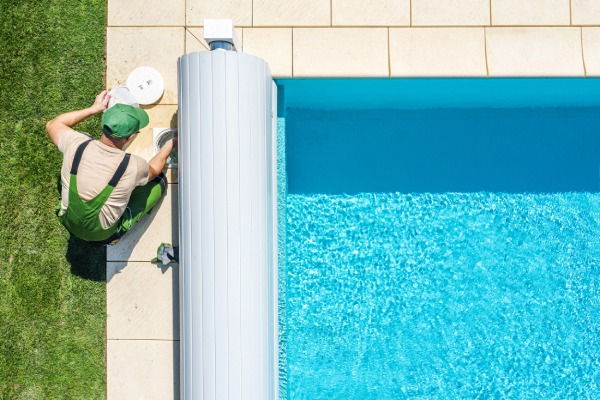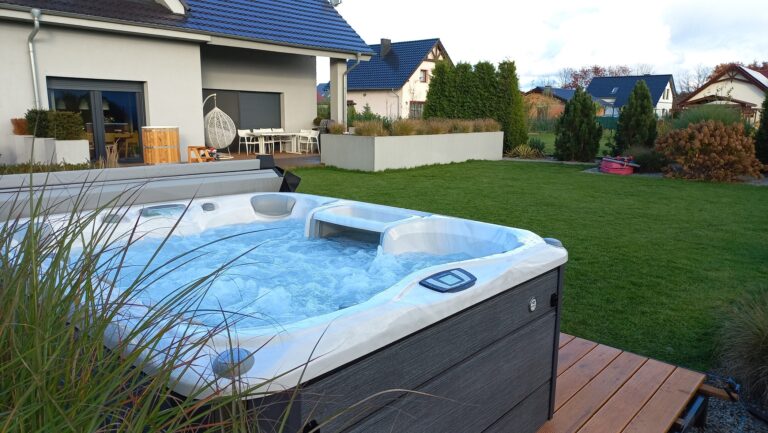Whether you have an in-ground or above-ground pool, your backyard is sure to be a refreshing paradise on hot summer days.
One of the most dreaded aspects of pool ownership is the potential of leaks forming, especially during the middle of swimming season when temperatures are soaring.
Pool leak repairs are something every pool owner will likely experience at some time or another, and they can come in a few different forms, some being easier to manage than others.
Whether you’re new to the pool world, or have enjoyed yours for many years, knowing how to spot and fix a leak is a skill you should have.
And we’re going to give you everything you need to do just that!
Keep reading to discover the most common signs of pool leaks, the types most often seen, and an easy DIY process to find and fix a leak in your pool.
Let’s dive in!
Signs Your Pool Has a Leak
Pool leaks can quickly result in extensive damage if not found and repaired in a timely manner, so it’s crucial to be aware of what a leak in your pool may look like.
Some of the most common signs your pool has a leak include:
- Increased water loss (more than 2 inches a week)
- Air in your plumbing system
- Unexpected wet areas around your pool and equipment
- Structural changes to the surrounding deck, such as lifting or sinking
And, of course, the most stark sign your pool has a leak would be if you’ve spotted a crack forming!
4 Most Common Pool Leaks
As mentioned above, pool leaks can appear in various areas of your pool, and they aren’t exclusive to the physical shell of your pool.
In fact, it’s not uncommon to discover a worn-down O-ring, causing water to trickle out of your plumbing system!
When it comes to spotting a leak, you’ll want to consider four aspects, including the:
- Pool liner
- Skimmer
- Pool lights
- Plumbing system

How Do You Find a Leak In Your Pool?
If you’ve noticed warning signs of a leak, it’s crucial you take the steps necessary to find the leak and take the steps to repair it.
To do this, you’ll need to follow a simple three-step process.
Step 1: Check Your Filter System
First and foremost, you’ll want to do a quick inspection of your pool’s filter system. This includes aspects like your pump, chlorinator, and heater if you have one, as well as any connections throughout your accessible plumbing.
Checking these components first will help you rule out the more accessible parts, and save you time if the leak is indeed coming from your filter system.
Step 2: Verify It’s Not Evaporation
The next step is to ensure the water loss you’re experiencing isn’t simply from evaporation.
Typically, pools lose anywhere from one to two inches of water a week, but the size of your pool, the humidity, and its exposure to the sun can all influence how much evaporation you experience.
This makes it particularly important to do what’s known as a “bucket test” whenever you suspect there may be a leak in your pool.
How To Do A Bucket Test
To do this, you simply fill up a five-gallon bucket with some water from your pool, and set it on one of the steps, so that the bottom half is still in the water.
You want to ensure the amount of water in the bucket matches the water level on the outside of the bucket.
Now that you have equal water levels, simply mark the water level on the outside of the bucket with a piece of duct tape or a waterproof marker.
Then, simply turn off your circulating pump and wait 24 hours.
The Results
Once it’s been 24 hours, you can determine if your pool is leaking or if your water loss is from evaporation by comparing the water levels inside and outside the bucket.
If they’ve gone down the same amount, then it’s safe to assume your dropping water levels are from evaporation.
However, if your pool’s water level is now below that of the water in the bucket, you most likely have a leak, and you’ll need to repeat the process with the pump on.
By doing this again but with the pump running, you’ll be able to narrow down if there’s something in your circulation system that may be causing the leak.
If you repeat this process and find that the water level in your pool drops below the one in the bucket, it signals your filter system or plumbing is likely the culprit of the leak.
Step 3: Perform a Dye Test
The last step you need to take when trying to pinpoint where your pool leak is includes a dye test.
To do this, you’ll need to buy a leak finder dye for pools from your local pool supply store. This dye will be added directly to your pool, and works by being pulled into a current that the leak is creating.
For this step, you’ll want to have some way to mark any leaks you find, so you’ll also want to have some waterproof tape on hand.
How To Use Leak Finding Dye
In order for this to work correctly, you’ll need perfectly still water, so you’ll want to turn off anything that causes movement in your pool, such as your pump.
This ensures that when you add the dye, it’s not moving through the water from anything other than a leak.
Once your water is still, add some dye to an area you suspect there may be a leak, such as near your skimmer or lights. Make sure you don’t touch the water while adding the dye.
Then, simply watch to see if it begins moving. If there’s a leak nearby, it’ll be pulled in that direction, leading you directly to the leak!
Once you know where the leak is, mark it with a piece of your tape so you can easily find it when you’re ready to make your pool leak repair.
Repeat this process anywhere you’re worried a leak may be.
If you have an in-ground pool and are concerned it’s your skimmer that’s causing your water loss, simply remove the cover and add some of the dye to the water. If it gets pulled toward the seam between your skimmer and the concrete, you’ve found your culprit!

An Easy DIY Pool Leak Repair
Now that you know where your repairs likely need to be made, it’s time to fix the issue!
The steps you take to repair the leak will be based on what type of leak you’re experiencing, so we’ve broken them down into the most common ones below.
How To Repair a Damaged Pool Liner
First and foremost, if your vinyl liner has a hole and needs to be repaired, you don’t need to drain it!
There are ample ways to quickly repair small tears in your liner underwater, making this a simple repair for any DIYer.
For this repair, you’ll need to pick up a vinyl patch kit or some waterproof tape made specifically for patching pool liners.
These patches can last for many years when properly applied and are often even UV resistant to ensure they don’t degrade too quickly.
When applying a patch or covering the hole with waterproof tape, you’ll want to take your time to ensure you don’t end up with air bubbles underneath.
After cleaning the area around the leak, you’ll need to apply the patch closely, following the directions on its packaging.
How to Repair a Leaking Skimmer
If you performed the dye test above on your skimmer and discovered it as the source of your leak, it’s most likely being caused by your skimmer coming detached from the concrete.
The most common way to repair this leak is with underwater repair putty.
You’ll want to start with a clean surface. After cleaning the area around the leak, gently sand it to help improve the bond between it and the putty.
Then, simply follow the instructions on the package to correctly apply it to the leaking seam, ensuring you leave behind a smooth repair.
How to Repair a Leaking Pipe
A telltale sign of a leaky pipe is an unexpected puddle forming below its connection.
Talk to your pool supply experts to find the right products to repair leaking pipes. You’ll be looking for Teflon tape and a 100% silicone sealant.
After gathering the necessary supplies, turn off the power to your filter system, and disconnect the damaged portion of the pipe.
If the pipe itself is the problem, replace the whole pipe. However, the most likely issue is a leaky connection between two sections of pipe.
If this is the case, simply add the sealant to the outer threaded portion of the pipe before wrapping it with the Teflon tape.
Then re-attach the two pieces of pipe, being careful not to over-tighten them, and allow it time to cure before turning your system back on.
How to Repair a Crack In a Concrete or Plaster Pool
Finally, if you have a concrete or plaster pool and you need to repair a crack that’s causing the leak, you’ll need a two-part underwater epoxy putty.
For smaller cracks, you can make the pool leak repair without draining your pool.
When using the underwater epoxy, carefully follow the instructions on the package to combine the putty.
Then form it into the right shape for the crack you’re fixing. You’ll want a ball for a hole or a rope for a longer crack.
If you’re facing a significant amount of work and repairing more than a small leak, you’ll need to drain your pool to make the necessary repairs.
At this point, it’s worth considering contacting a professional pool repair team since your pool will need to be drained.
When To Call In The Professional Pool Leak Repair Techs
When it comes to repairing any issue with your pool, it’s always worth considering if it’s best left to the professionals.
Many minor repairs can be completed on your own if you have the right knowledge and enjoy a challenge.
However, for larger jobs, or those you simply don’t feel comfortable doing, it’s never a bad idea to involve a team or pool repair experts.
This can save you ample time and stress, and can even save you money in the long run by doing the job properly, and reducing the amount of materials and tools you need to buy to make the repair.
Ultimately, when you decide to include the professionals in your repair is up to you and will depend on your skillset and the size of the job.
Pool Leak Repair in Huntsville, AL
For everything pool care, the experts at Johnson Pools & Spas are here to help. We’ve been serving the residents of Huntsville and the surrounding areas since 1977, and we’ve seen it all!
Whether you need a pool leak repaired, are considering updating your existing pool, or simply want to transform your backyard into your own personal oasis, we can help you every step of the way.
Contact us, or visit our pool supply store today to find everything you need to expertly care for your pool. Our team will be thrilled to help you with all your backyard leisure needs!


